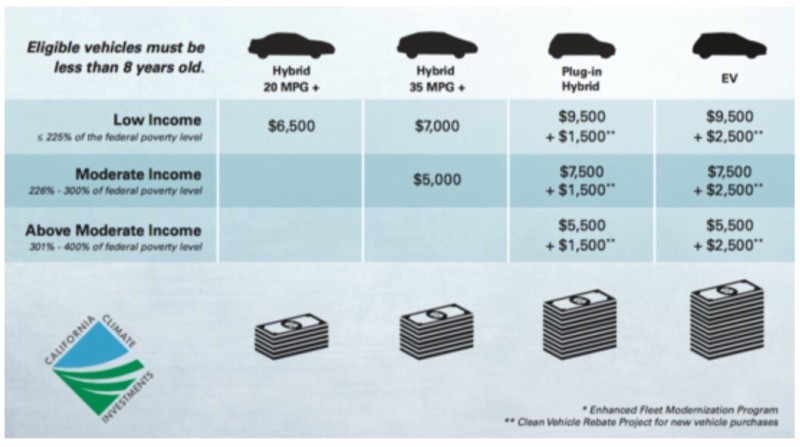Friday, 26/12/2025 | 11:56 GMT+7
Those living in certain parts of the state of California who qualify as low-income residents and have an old gas hog that pollutes heavily will now have the option of receiving up to $12,000 in subsidies to replace their old vehicle and purchase a cleaner, fuel-efficient vehicle, according to recent reports.
In cooperation with the California Air Resources Board, officials will be providing locals in the Greater Los Angeles and San Joaquin Valley areas with the sliding-scale retire-and-replace initiative. As one can no doubt guess considering the words “sliding-scale,” higher incentives are available to lower-income people/families than to higher-income ones.
While purchases of new fuel-efficient gas-powered cars, hybrids, plug-in hybrids (PHEVs), and battery-electric vehicles (EVs) are all supported, the highest incentives will be provided to those who go fully electric.

Also worth noting here is that those who wish to get rid of their old car and use public transportation instead can receive several thousand dollars worth of incentives as well.
Here’s a brief overview of what’s on offer (via Green Car Congress):
Low Income (≤ 225% of the federal poverty level, FPL) — Buyers in this income level who replace a scrapped car with a conventional hybrid car (eg Toyota Prius) that is less than 8 years old that gets 20 mpg or greater, are eligible for $6,500 in incentives. If the replacement car gets 35 mpg or greater (Toyota Prius or Honda Insight), that goes up to $7,000. A plug-in hybrid (eg Chevy Volt), or an electric car (eg Nissan Leaf) receives $9,500. Lower-income consumers who would like to replace their dirty cars with more fuel efficient conventional cars would still qualify to receive up to $4,500.
In addition, up to $2,000 for a charging unit at a single residence or multi-unit dwelling is available for the purchase of battery electric cars. In the case of either a brand new plug-in hybrid or electric car, buyers receive an additional $1,500 and $2,500, respectively, from a separate program, known as the Clean Vehicle Rebate Project.
Moderate Income (226% – 300% of FPL) — Buyers who replace a scrapped car with a conventional hybrid model that gets 35 mpg or greater receive $5,000, rising to $7,500 for a plug-in hybrid or electric car. (In addition, buyers can receive up to $2,000 for a charging unit for battery electric cars, and if those are brand new cars, an additional $1,500 or $2,500, respectively.)
Above Moderate Income (301% – 400% of federal poverty level) — Buyers who replace a scrapped car with a plug-in hybrid or electric car receive $5,500—which includes an additional incentive of up to $2,000 for the charging unit for battery electric cars, and an additional $1,500 or $2,500, respectively, if they are brand new.
Further incentives for the purchase of hybrids, PHEVs, and EVs are also on offer for low-income recipients who live in a “disadvantaged census tract.”
Truong Duy








 Webinar 2: “Financial Support for Energy Efficiency Enterprises – Opportunities and Challenges”
Webinar 2: “Financial Support for Energy Efficiency Enterprises – Opportunities and Challenges”
 Vietnamese enterprises achieve green growth and cut costs through energy efficiency
Vietnamese enterprises achieve green growth and cut costs through energy efficiency
 Capacity Building for Program Implementing Entity
Capacity Building for Program Implementing Entity
 Enhance Energy Efficiency Knowledge for Managers of Cement Industrial Enterprises
Enhance Energy Efficiency Knowledge for Managers of Cement Industrial Enterprises
 Capacity building for participating financial institutions of the VSUEE Project
Capacity building for participating financial institutions of the VSUEE Project
 Capacity building for participating financial institutions in Ho Chi Minh City
Capacity building for participating financial institutions in Ho Chi Minh City
 Strengthening capacity for energy management officers of local government agencies
Strengthening capacity for energy management officers of local government agencies